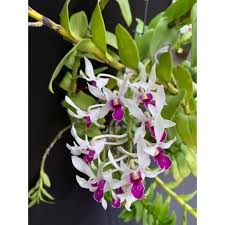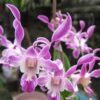# Disease Prevention Methods for Dendrobium Orchids

Dendrobium orchids, known for their stunning flowers and diverse species, are a favorite among horticulturists and plant enthusiasts alike. However, like all plants, they are susceptible to various diseases that can impact their health and beauty. Proper disease prevention is essential for ensuring that these orchids thrive and produce vibrant blooms. In this article, we will explore the common diseases affecting Dendrobium orchids, their symptoms, and effective methods for prevention and management.
## 1. Understanding Common Diseases Affecting Dendrobium Orchids
### 1.1 Fungal Diseases
Fungal infections are among the most prevalent issues facing Dendrobium orchids. They can manifest as leaf spots, rot, or blight and are often exacerbated by high humidity and poor air circulation.
#### 1.1.1 Root Rot
**Description**: Root rot is a severe condition caused by overwatering or poorly draining media. Fungi, such as Phytophthora or Pythium, thrive in soggy conditions and attack the roots.
**Symptoms**: Yellowing leaves, wilting, and mushy, blackened roots are common signs of root rot. In severe cases, the plant may collapse.
#### 1.1.2 Leaf Spot
**Description**: Leaf spot is characterized by small, dark spots on the leaves, often caused by fungal pathogens like Botrytis or Alternaria.
**Symptoms**: Dark, water-soaked spots that may expand over time, leading to leaf drop.
### 1.2 Bacterial Diseases
Bacterial infections can also affect Dendrobium orchids, usually thriving in warm, moist conditions.
#### 1.2.1 Bacterial Soft Rot
**Description**: Caused by bacteria such as Erwinia, soft rot affects the stems and leaves, often entering through wounds.
**Symptoms**: Affected areas become soft, mushy, and can emit a foul odor. The infection can rapidly spread throughout the plant.
### 1.3 Viral Diseases
Viruses can cause various symptoms in Dendrobium orchids, often leading to stunted growth and poor flowering.
#### 1.3.1 Cymbidium Mosaic Virus (CyMV)
**Description**: While primarily affecting Cymbidium orchids, CyMV can also infect Dendrobium species. It is spread through infected plant material or tools.
**Symptoms**: Mottled leaves, stunted growth, and reduced flowering. There is no cure for viral infections, making prevention crucial.
## 2. Key Prevention Strategies
Preventing diseases in Dendrobium orchids requires a combination of cultural practices, environmental management, and proactive care. Here are essential methods to ensure the health of your orchids:
### 2.1 Selecting Healthy Plants
When acquiring Dendrobium orchids, always choose healthy specimens from reputable sources. Inspect plants for signs of disease, such as yellowing leaves or soft spots. Quarantining new plants for a few weeks can help prevent the introduction of pests or diseases into your collection.
### 2.2 Proper Watering Techniques
Overwatering is one of the leading causes of root rot and other fungal diseases in Dendrobium orchids. To prevent this:
– **Watering Frequency**: Water only when the top inch of the potting medium feels dry. This helps maintain proper moisture levels.
– **Water Quality**: Use distilled or rainwater when possible, as tap water may contain harmful chemicals or salts that can damage roots over time.
– **Watering Method**: Water in the morning to allow excess moisture to evaporate throughout the day. Avoid wetting the leaves to minimize the risk of fungal infections.
### 2.3 Choosing the Right Potting Media
Selecting appropriate potting media is crucial for ensuring proper drainage and aeration, reducing the risk of rot.
– **Mix Composition**: Use a well-draining orchid mix, typically composed of bark, sphagnum moss, or perlite. Avoid compact soils that retain too much moisture.
– **Repotting**: Repot Dendrobium orchids every 1-2 years or when the media breaks down. This helps maintain optimal drainage and prevents diseases associated with decomposed material.
### 2.4 Ensuring Adequate Air Circulation
Good air circulation is vital for preventing fungal and bacterial diseases. To enhance airflow around your Dendrobium orchids:
– **Spacing**: Ensure adequate spacing between plants to allow for airflow.
– **Ventilation**: If growing indoors, use fans or open windows to promote air movement. Outdoors, place orchids in a location where they can receive gentle breezes.
### 2.5 Maintaining Proper Humidity and Temperature
Dendrobium orchids thrive in specific humidity and temperature ranges. Managing these conditions can help prevent disease.
– **Humidity Levels**: Aim for humidity levels between 50-70%. Use humidity trays or a room humidifier to maintain consistent moisture levels.
– **Temperature Control**: Keep temperatures between 70-85°F (21-29°C) during the day and cooler (55-65°F or 13-18°C) at night. Avoid exposing plants to extreme temperature fluctuations.
### 2.6 Fertilization Practices
Healthy orchids are more resilient to diseases. Proper fertilization can enhance plant vigor and promote strong blooms.
– **Fertilizer Type**: Use a balanced orchid fertilizer during the growing season, following the recommended dilution rates.
– **Feeding Schedule**: Fertilize every two weeks during active growth and reduce frequency during dormancy. Over-fertilization can lead to salt buildup, damaging roots and increasing disease susceptibility.
### 2.7 Regular Inspection and Maintenance
Routine inspections can help identify potential issues before they escalate into severe problems.
– **Leaf Inspection**: Regularly check leaves for signs of spots, discoloration, or pests. Early detection can prevent disease spread.
– **Cleaning**: Wipe leaves with a damp cloth to remove dust, improving photosynthesis and allowing you to monitor for pests and disease.
## 3. Integrated Pest Management (IPM)
Implementing an Integrated Pest Management (IPM) approach can help manage pests that may introduce diseases to your Dendrobium orchids.
### 3.1 Monitoring for Pests
Common pests like aphids, mealybugs, and spider mites can weaken orchids and make them more vulnerable to diseases. Regularly check for signs of infestations.
### 3.2 Biological Controls
Introduce beneficial insects, such as ladybugs or predatory mites, to manage pest populations naturally. These predators can help control pest outbreaks without chemical intervention.
### 3.3 Chemical Controls
If pest populations become overwhelming, use chemical controls as a last resort. Choose targeted insecticides that are safe for orchids and follow application instructions carefully.
## 4. Treatment and Management of Existing Diseases
Despite preventive measures, diseases can still occur. Here’s how to manage them effectively:
### 4.1 Fungal Infections
For fungal diseases, prompt action is crucial:
– **Treatment**: Apply a fungicide specifically designed for orchids. Follow the manufacturer’s instructions regarding application rates and intervals.
– **Pruning**: Remove and dispose of infected leaves or stems to prevent the spread of the fungus. Ensure that cutting tools are sterilized before and after use.
### 4.2 Bacterial Infections
Bacterial soft rot requires immediate attention:
– **Treatment**: Cut away infected areas and use a bactericide if necessary. Ensure that the cuts are made with sterile tools.
– **Improving Conditions**: Increase air circulation and reduce humidity around the affected plant to limit bacterial growth.
### 4.3 Viral Infections
Unfortunately, there is no cure for viral infections:
– **Management**: If a plant is diagnosed with a viral infection, it’s best to remove it from the collection to prevent spread. Always practice good sanitation, including disinfecting tools and surfaces.
## 5. Conclusion
Maintaining healthy Dendrobium orchids requires a proactive approach to disease prevention. By understanding common diseases and their symptoms, implementing effective prevention strategies, and being vigilant in care, you can ensure that your orchids thrive. Regular monitoring, proper cultural practices, and an integrated pest management strategy are essential components in safeguarding your plants against diseases. Ultimately, a healthy Dendrobium orchid not only provides visual beauty but also enhances your gardening experience, allowing you to enjoy the vibrant blooms and delightful fragrances they offer. Embrace the journey of caring for Dendrobium orchids, and enjoy the rewards of a flourishing, disease-free garden!

